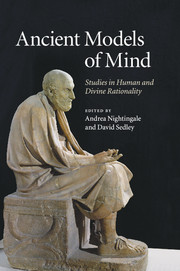Book contents
- Frontmatter
- Contents
- List of contributors
- Introduction
- 1 Plato on aporia and self-knowledge
- 2 Cross-examining happiness: reason and community in Plato's Socratic dialogues
- 3 Inspiration, recollection, and mimēsis in Plato's Phaedrus
- 4 Plato's Theaetetus as an ethical dialogue
- 5 Contemplating divine mind
- 6 Aristotle and the history of skepticism
- 7 Stoic selection: objects, actions, and agents
- 8 Beauty and its relation to goodness in Stoicism
- 9 How dialectical was Stoic dialectic?
- 10 Socrates speaks in Seneca, De vita beata 24–28
- 11 Seneca's Platonism: the soul and its divine origin
- 12 The status of the individual in Plotinus
- A. A. Long: publications 1963–2009
- Bibliography
- Index
7 - Stoic selection: objects, actions, and agents
Published online by Cambridge University Press: 06 December 2010
- Frontmatter
- Contents
- List of contributors
- Introduction
- 1 Plato on aporia and self-knowledge
- 2 Cross-examining happiness: reason and community in Plato's Socratic dialogues
- 3 Inspiration, recollection, and mimēsis in Plato's Phaedrus
- 4 Plato's Theaetetus as an ethical dialogue
- 5 Contemplating divine mind
- 6 Aristotle and the history of skepticism
- 7 Stoic selection: objects, actions, and agents
- 8 Beauty and its relation to goodness in Stoicism
- 9 How dialectical was Stoic dialectic?
- 10 Socrates speaks in Seneca, De vita beata 24–28
- 11 Seneca's Platonism: the soul and its divine origin
- 12 The status of the individual in Plotinus
- A. A. Long: publications 1963–2009
- Bibliography
- Index
Summary
Selection (ἐκλογή, selectio) is a key concept in Stoic ethics. It has a prominent role in attempts by Diogenes of Babylon and Antipater of Tarsus in the second century bce to explain and defend the Stoic conception of the good life or human telos. It is a major target of ancient criticism from their contemporary Carneades down to Plutarch and Alexander. And it is central to recent attempts to reconstruct Stoic moral psychology, which take selection to be a distinctive kind of motivation, a species of rational “impulse” (ὁρμή) that differs both from the uniquely virtuous “dispassions” (εὐπάθειαι) of a sage, and from the inherently defective “passions” (πάθη) found in everyone else. So construed, a selection is simply an impulse to act in pursuit of an objective viewed as “indifferent”: not as either good or bad (as in dispassions correctly and passions incorrectly), but as “preferred” or “dispreferred,” on the basis of its “selective” value or disvalue. This intermediate form of motivation, which is common to everyone, sages and others alike, is supposed to help explain how we can make “progress” from vice toward virtue: simply by transforming our passions into selections, that is, by viewing as “indifferent” but “preferred” much of what we ordinarily consider “good.” It also underpins recent accounts of practical reasoning in Stoicism: the correct way to decide what to do is simply to select the available option that promises the greatest selective value.
- Type
- Chapter
- Information
- Ancient Models of MindStudies in Human and Divine Rationality, pp. 110 - 129Publisher: Cambridge University PressPrint publication year: 2010
- 1
- Cited by



